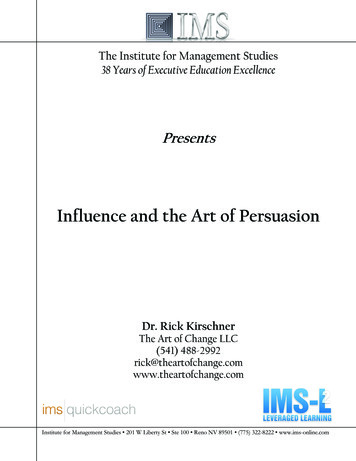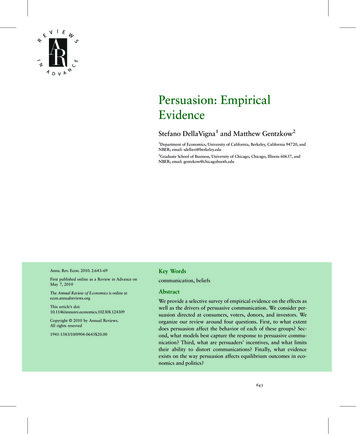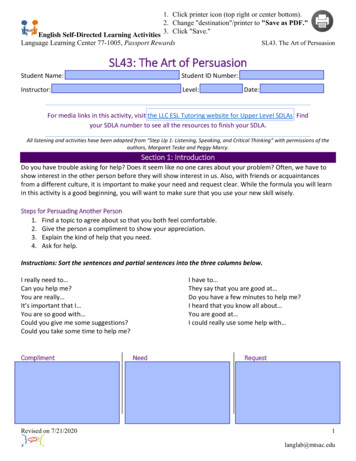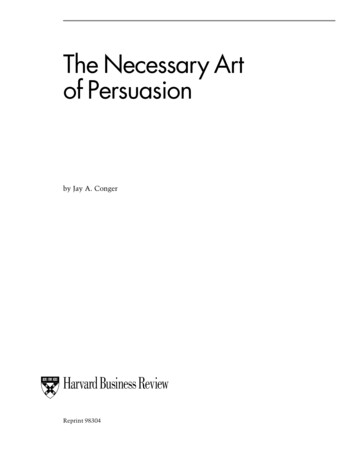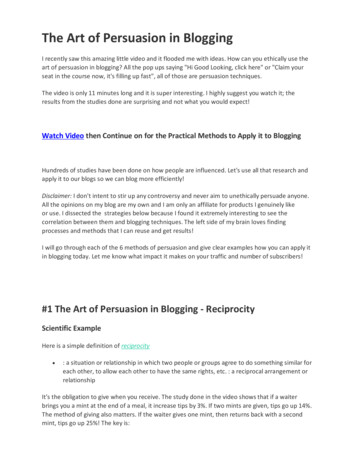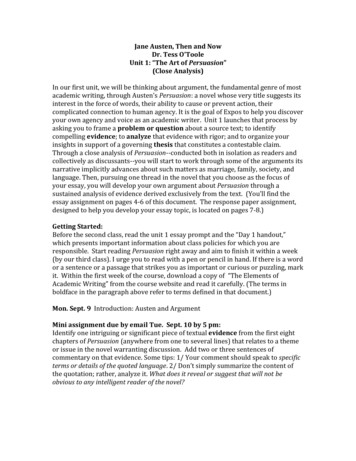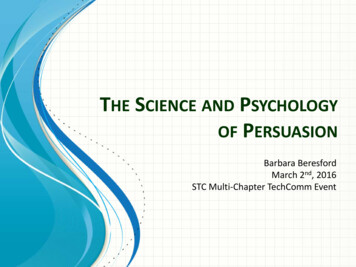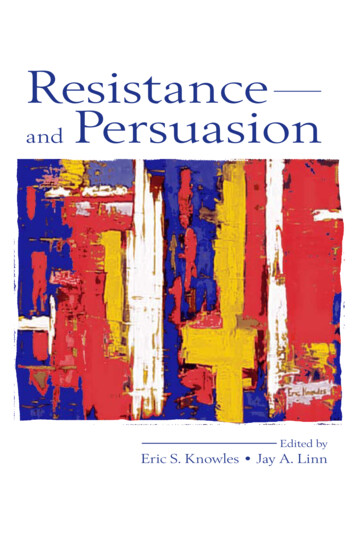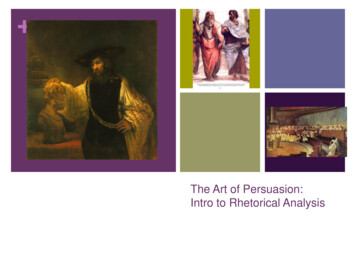
Transcription
The Art of Persuasion:Intro to Rhetorical Analysis
What is Rhetoric?
What is Rhetorical Analysis? While the term "rhetorical analysis" is, at first, ratherintimidating for many people, it is easily understood (at least atits most basic) when broken down and defined.RhetoricThe art of persuasionAnalysisThe breaking down of somethingits parts and interpreting how thoseparts fit togetherIn rhetorical analysis, then, we examine how authors attempt topersuade their audiences by looking at the various componentsthat make up the art of persuasion.
Everything’s an argument! Every text—oral, written, or visual—is, in some sense rhetorical;each one is a strategic presentation of particular ideas. Human beings both produce and receive such texts; as such, wemust understand what they mean. Typically, this is done implicitly;we understand the meaning of a text without thinking about how orwhy it works the way it does. Rhetorical analysis asks us precisely that: to understand how textscreate meaning, how they construct knowledge, and how theymake us take action. Rhetorical analysis, then, helps us to understand explicitly (ratherthan simply implicitly, as most of us do) how the language of a textworks and how we can use such language to work for us.
Rhetorical AnalysisUsing the Joliffe Framework Design
Rhetorical Situation: ExigenceProblem, incident, or situation causing the writer to write thepieceWhat prompted the writing of this piece?Most likely, the piece would not have been written if it had notbeen for this.
Rhetorical Situation: AudienceAn audience has either an:1.Immediate response2.Intermediate response (think about later)So, which type of response does the author want from theaudience?In this way, the audience shapes the rhetoric.No audience is a tabula rosa.
Rhetorical Situation: PurposeThe author considers a purpose of the writing in a sense ofconsideration for what the audience feels.
Appeals
Appeals: Logos An appeal to logic An attempt to persuade the reader by presenting a logicalargument If, then statements Syllogistic inferences/conclusions Deductive reasoning
Appeals: LogosThe central appeal of anything is that it must be logical.Without logic, nothing that follows is reasonable.You must consider the logos within the author’s writing.
Appeals: Ethos The ethical appeal An attempt to persuade based on moral grounds Right vs. Wrong Good vs. Evil
Appeals: Pathos An appeal to emotion An attempt to persuade the reader by causing them to respondto the way an issue/topic makes them feel Can invoke bias or prejudice Uses non-logical appeals Informal language
Aristotle’s Rhetorical TriangleWriter/ EthosAudience/ PathosContext/ Logos
Aristotle’s Rhetorical TriangleWriter/ Ethos- Written voiceNon-logical appeals- Make audience believe writer istrustworthyFigurative language- Demonstrate research timeBias/prejudice- Support reasons withConnotative languageappropriate, logical evidenceEuphemism- Carefully crafted and editedImagery- Writer knows andTonerespects audienceInformal language- Concern aboutcommunicating with audience- Convince audience writeris reliable, knowledgeableAudience/ PathosContext/ Logos- modes of discourse- analogies, metaphors- evidencechronologicalorder- inductive reasoning- Allusions (Bible, lit., myth) - testimony- deductive reasoning- authorities- cite commonly held beliefs - style manipulation- cite traditional culture- research, facts
Tone You must understand Logos, Ethos, and Pathos to understandthe Tone Logos, Ethos, and Pathos all contribute to determining the Tone If you don’t recognize the Tone of the piece, you misseverything that follows
What is Tone? The writer’s or speaker’s attitude toward a subject, character, oraudience Conveyed through the author’s: Choice of words (diction) Word order (syntax) Detail, imagery, and language (figurative language)
Organization/Structure/Form Always work chronologically when analyzing a piece ofliterature. You cannot identify shifts in tone and other elements if youdon’t look at it chronologically.
Surface Features
Surface Features: Diction What is diction? Diction is word choice intended to convey a certain effect To communicate ideas and impressions To evoke emotions To convey your views of truth to the reader
Surface Features: Syntax What is Syntax? The arrangement and order of words in a sentence
Surface Features: SyntaxSentence Structure1.-Short sentences are often emphatic, passionate, or flippant-Longer sentences often suggest the writer’s thoughtfulresponseArrangement of Ideas in a Sentence2.-Are they set out in a particular way for a purpose?Arrangement of Ideas in a Paragraph3.-Is there evidence of any pattern or structure?
Surface Features:Imagery & Figurative LanguageThe use of language to appeal to the senses Simile, metaphor Allusion Alliteration Etc.
Surface Features Consider how surface features contribute to the message Syntactical elements are usually there for either parallelism ordifference All of those multisyllabic terms are there to show how things inthe piece are the same or different (antithesis, parallelism, etc.) Figurative language is metaphorical; therefore, it makesabstract things concrete
The Cannons of Rhetoric
The Cannons of Rhetoric Aristotle and other Greek rhetoricians thought of rhetoric ashaving five canons or established principles. These principlesoutline the systems of classical rhetoric Invention: To discover the available means of persuasion Arrangement: To select and assemble the argument effectively Style: To present the argument cogently and eloquently Memory: To speak extemporaneously Delivery: To effectively use voice, gestures, text, and images
Invention:To discover the available means of persuasion Exigence and audience are the primary building blocks of arhetorical situation, in which a person is compelled tocommunicate with an audience. . We must figure out what to say to achieve our desired goal. Andthis is the role of the first canon of rhetoric: invention. A rhetorical situation demands that we discover: The audience and their needs/desires/thoughts regarding the situation.What types of evidence (facts, testimony, statistics, laws, maxims,examples, authority) to employ with the particular audience.How best to appeal to the audience (logic, emotions, character).Which topics to employ to examine the situation and generate ideas.The best timing and proportion for communication (kairos).
Arrangement:To assemble the argument effectively The 5-paragraph essay model many of us learned is based on classic Greekand Roman structures. Its parts include: Introduction (exordium)Statement of fact (narratio)Confirmation or proof (confirmatio)Refutation (refutatio)Conclusion (peroratio) . In the classic model, the introduction must also set the tone for the audienceand make them favorably disposed toward the speaker. The Greeks especially were concerned that any who would speak in publicestablish his ethos and community connection as part of introducing an issue. The confirmation or proof section contrasts with the refutation. The formerconstructs the argument; the latter challenges the argument of the opposition.
Style:To present the argument cogently and artistically The canon of style concerns the choices rhetors make to formstatements that will have calculated (surmised) effects on theaudience. Style is most often thought of as making choices about thelevels of language, i.e. grand, middle, and low. And style alsoconcerns the choices one makes of tropes and schemes.
MemoryTo speak extemporaneously The ancient Greeks thought that reading a speech from a text wassign of a poor rhetor. And a poor rhetor was an ineffectivepolitician. A citizen might hire a logographer to write a speech, butthe citizen would then memorize it for delivery. In addition, the systems of classical rhetoric were designed to beused on the fly. Several of the famous Sophists used to entertaincrowds by expounding upon any given subject extemporaneously.The canon of memory helped them retain and marshal set bits ofargument as well as whole discourses. Modern rhetors no longer rely on the canon of memory. We havecomputers and Tele-Prompt-Rs to help us deliver effectiveaddresses. The ability to sustain an effective extemporaneousspeech has been largely lost except to those rare individuals whohave a natural talent for speaking on the fly.
Delivery:To effectively use voice, gestures, text, and images. For the Greeks, a good speaker was a good person. It was difficultfor them to believe that eloquence could reside in an unworthyindividual. This idea seems naive to us today, especially after a parade ofsliver-tongued, 20th century despots and scoundrels. In manycases today, we believe that too much skill in public speaking mustbe a sign of the speaker's deceptive ability and intent. How farwe've come from that Greek ideal. But, like the Greeks, we still find the ability to speak effectively, orwrite well, a prime source of entertainment. Anyone who wouldengage the public sphere on issues of civic concern would do wellto consider the canon of delivery, i.e. the conventions of modernspeaking and writing.
Rhetorical theories &strategies
Make way for the mightyenthymeme!!(And syllogism)
The Syllogism A syllogism is a kind of logical argument in which one proposition(the conclusion) is inferred from two others (the premises) of acertain form In Aristotle's Prior Analytics, he defines syllogism as "a discoursein which, certain things having been supposed, something differentfrom the things supposed results of necessity because thesethings are so." (24b18–20) Despite this very general definition, helimits himself first to categorical syllogisms (and later to modalsyllogisms) The syllogism is at the core of deductive reasoning, where factsare determined by combining existing statements, in contrast toinductive reasoning where facts are determined by repeatedobservations.
The Syllogism A syllogism (henceforth categorical unless otherwise specified) consists ofthree parts: the major premise, the minor premise, and the conclusion. In Aristotle, each of the premises is in the form "Some/all A belong to B,"where "Some/All A" is one term and "belong to B" is another, but moremodern logicians allow some variation. Each of the premises has one term in common with the conclusion: in amajor premise, this is the major term (i.e., the predicate) of the conclusion;in a minor premise, it is the minor term (the subject) of the conclusion. For example: Major premise: All humans are mortal.Minor premise: Socrates is a human.Conclusion: Socrates is mortal.
Examples of Syllogisms Example #1 All men are animals.All animals are mortal.All men are mortal.Example #2 No reptiles have fur.All snakes are reptiles.No snakes have fur.Example #3 All kittens are playful.Some pets are kittens.Some pets are playful.
Enthymemes An enthymeme, in its modern sense, is an informally statedsyllogism (a three-part deductive argument) with an unstatedassumption that must be true for the premises to lead to theconclusion. In an enthymeme, part of the argument is missing because it isassumed. In a broader usage, the term "enthymeme" is sometimes usedto describe an incomplete argument of forms other than thesyllogism.
Three Parts of an Enthymeme The following quotation is an example of an enthymeme (usedfor humorous effect). "There is no law against composing music when one has no ideaswhatsoever. The music of Wagner, therefore, is perfectly legal." —Mark Twain.The three parts: There is no law against composing music when one has no ideaswhatsoever. (premise) The music of Wagner, therefore, is perfectly legal. (conclusion) Wagner has no ideas. (implicit premise)
Pulling Enthymeme from Argument If intelligent design people won’t name the designer, (every effect in a logical argument must have a cause) Then intelligent design isn’t a logical argument. If intelligent design people do name the designer, (And if such a metaphysical designer must be outside the realm ofscience)Then intelligent design isn’t science.
Pulling an Enthymeme from anargument Martha: What issue do you have exactly with teaching bothapproaches, intelligent design and evolution, in school? Isn’tthis hijacking Darwin and forcing him to teach biology? Sincewhen does being balanced mean believing in only OEapproach, belief, theory, etc.? David: Oh, I’m certainly for teaching both sides, whenever thereare two of them. But in this case– creationism and biology–we’re dealing with a logical fallacy: if intelligent design peoplerefuse to name the designer, then they have an effect without acause, a disconnect that Aristotle, pagan as he was, abhorred.If they can name the designer, then they’re in the realm of faith,not science.
Toulmin on Argument The theory of argument that informs discussion of argumentative invention in thiscourse is drawn from Stephen Toulmin's The Uses of Argument. Toulmin's theorywas designed, among other things, to analyze the practical arguments ofeveryday life. Toulmin's theory based on a layout of argument elements (as depicted below).The basic elements may be defined roughly as follows: Claim--A statement or proposition that the arguer wants the audience to accept.Data--The statements or reasons put forward by the arguer to get the audience to acceptthe claim.Warrant--When the arguer relates the data to the claim, a relationship between the two isasserted or assumend. The warrant is an inference rule that "authorizes" this relationship.(Warrants are best thought of as conditional statements in "if, then" form.Backing--The principles of the field at stake in the argument from which the warrant isabstracted or drawn.In Toulmin's view, every acceptable argument may be layed out using theseelements. However, arguments in actual discourses infrequently express theirwarrants and backing in words. These elements are usually suppressed byarguers.
Example Toulmin layout
Stasis Theory Stasis names a procedure within rhetorical invention by which onewould ask certain questions in order to arrive at the point at issue inthe debate, the "stasis." Four such basic kinds of conflict were categorized by the Greeksand Romans: conjectural, definitional, qualitative, and translative.Questions to FindType of QuestionType of StasisDid he do it?Of factConjectural stasisWhat did he do?Of definitionDefinitional stasisWas it just/ expedient?Of qualityQualitative stasisIs it the right venue forissue?Of jurisdictionTranslative stasis
Stasis Theory Stasis is a way of looking at an argument’s structure to decide thetype of issue the argument addresses . The questions would be posed in sequence, because eachdepended on the question(s) preceding it. Together, the questionshelped determine the point of contention in an argument, the placewhere disputants could focus their energy, and hence what kind ofan argument to make. A modern version of those questions might look like the following: Did something happen?What is its nature?What is its quality?What actions should be taken?Here's how these questions might be used to explore a "crime."
A History of Rhetoric
A Brief History of Rhetoric:Ancient Israel Rhetorical skills were required and found wanting in biblicalfigure Moses as mentioned in Torah (c.1313 BCE)[6], whereMoses argued with God that he should not be the one to deliverthe message to the people by saying "Please, my Lord, I amnot a man of words." (Exodus 4:10). To this God responded "Is there not Aaron, your brother, theLevite?" (Exodus 4:14). Levites were the priestly tribe ofIsraelites that were occupied primarily with teaching, at thattime, in public, therefore Aaron was expected to be such a"man of words".
A Brief History of Rhetoric:The Greeks The earliest mention of oratorical skill occurs in Homer's Iliad, where heroes like Achilles, Hektor, and Odysseuswere honored for their ability to advise and exhort their peers and followers (the Laos or army) in wise andappropriate action. With the rise of the democratic polis, speaking skill was adapted to the needs of the public and political life of citiesin Ancient Greece, much of which revolved around the use of oratory as the medium through which political andjudicial decisions were made, and through which philosophical ideas were developed and disseminated. Formodern students today, it can be difficult to remember that the wide use and availability of written texts is aphenomenon that was just coming into vogue in Classical Greece. In Classical times, many of the great thinkers and political leaders performed their works before an audience,usually in the context of a competition or contest for fame, political influence, and cultural capital; in fact, many ofthem are known only through the texts that their students, followers, or detractors wrote down. As has already beennoted, rhetor was the Greek term for orator: A rhetor was a citizen who regularly addressed juries and politicalassemblies and who was thus understood to have gained some knowledge about public speaking in the process,though in general facility with language was often referred to as logôn techne, "skill with arguments" or "verbalartistry." See, Mogens Herman Hansen The Athenian Democracy in the Age of Demosthenes (Blackwell, 1991);Josiah Ober Mass and Elite in Democratic Athens (Princeton UP, 1989); Jeffrey Walker, Rhetoric and Poetics inAntiquity (Oxford UP, 2000). Rhetoric thus evolved as an important art, one that provided the orator with the forms, means, and strategies forpersuading an audience of the correctness of the orator's arguments. Today the term rhetoric can be used at timesto refer only to the form of argumentation, often with the pejorative connotation that rhetoric is a means of obscuringthe truth. Classical philosophers believed quite the contrary: the skilled use of rhetoric was essential to thediscovery of truths, because it provided the means of ordering and clarifying arguments.
A Brief History of Rhetoric:The Sophists Organized thought about public speaking began in ancient Greece.[citation needed]Possibly, the first study about the power of language may be attributed to thephilosopher Empedocles (d. ca. 444 BC), whose theories on human knowledge wouldprovide a basis for many future rhetoricians. The first written manual is attributed toCorax and his pupil Tisias. Their work, as well as that of many of the earlyrhetoricians, grew out of the courts of law; Tisias, for example, is believed to havewritten judicial speeches that others delivered in the courts. Teaching in oratory was popularized in the 5th century BC by itinerant teachers knownas sophists, the best known of whom were Protagoras (c.481-420 BC), Gorgias(c.483-376 BC), and Isocrates (436-338 BC). The Sophists were a disparate group who travelled from city to city making publicdisplays to attract students who were then charged a fee for their education. Theircentral focus was on logos or what we might broadly refer to as discourse, itsfunctions and powers. They defined parts of speech, analyzed poetry, parsed closesynonyms, invented argumentation strategies, and debated the nature of reality The word "sophistry" developed strong negative connotations in ancient Greece thatcontinue today, but in ancient Greece sophists were nevertheless popular and wellpaid professionals, widely respected for their abilities but also widely criticized for theirexcesses.
A Brief History of Rhetoric:Isocrates Isocrates (436-338 BC), like the sophists, taught public speaking as a means of humanimprovement, but he worked to distinguish himself from the Sophists, whom he saw asclaiming far more than they could deliver. He suggested that while an art of virtue or excellence did exist, it was only one piece, andthe least, in a process of self-improvement that relied much more heavily on native talentand desire, constant practice, and the imitation of good models. Isocrates believed thatpractice in speaking publicly about noble themes and important questions would function toimprove the character of both speaker and audience while also offering the best service toa state. He thus wrote his speeches as "models" for his students to imitate in the same way thatpoets might imitate Homer or Hesiod. His was the first permanent school in Athens and it islikely that Plato's Academy and Aristotle's Lyceum were founded in part as a response toIsocrates. Though he left no handbooks, his speeches ("Antidosis" and "Against theSophists" are most relevant to students of rhetoric) became models of oratory (he was oneof the canonical "Ten Attic Orators") and he had a marked influence on Cicero andQuintilian, and through them, on the entire educational system of the west.
A Brief History of Rhetoric:Plato Plato (427-347 BC) famously outlined the differences between true andfalse rhetoric in a number of dialogues, but especially the Gorgias and thePhaedrus. Both dialogues are complex and difficult, but in both Platodisputes the Sophistic notion that an art of persuasion, the art of theSophists which he calls "rhetoric" (after the public speaker or rhêtôr), canexist independent of the art of dialectic. Plato claims that since Sophists appeal only to what seems likely orprobable, rather than to what is true, they are not at all making theirstudents and audiences "better," but simply flattering them with what theywant to hear Plato coined the term "rhetoric" both to denounce what he saw as thefalse wisdom of the sophists, and to advance his own views on knowledgeand method. Plato attempts to distinguish the rhetoric common to Socratic questioningfrom Sophistry.
A Brief History of Rhetoric:Aristotle Plato's student Aristotle (384-322 BC) famously set forth an extendedtreatise on rhetoric that still repays careful study today. In the first sentence of The Art of Rhetoric, Aristotle says that "rhetoric isthe counterpart [literally, the antistrophe] of dialectic." As the "antistrophe"of a Greek ode responds to and is patterned after the structure of the"strophe" (they form two sections of the whole and are sung by two partsof the chorus), so the art of rhetoric follows and is structurally patternedafter the art of dialectic because both are arts of discourse production.Thus, while dialectical methods are necessary to find truth in theoreticalmatters, rhetorical methods are required in practical matters such asadjudicating somebody's guilt or innocence when charged in a court oflaw, or adjudicating a prudent course of action to be taken in a deliberativeassembly He identifies three steps or "offices" of rhetoric--invention, arrangement,and style--and three different types of rhetorical proof: ethos, logos, andpathos
A Brief History of Rhetoric:The Romans The Romans, for whom oration also became an important part of publiclife, saw much value in Greek rhetoric, hiring Greek rhetoricians to teach intheir schools and as private tutors, and imitating and adapting Greekrhetorical works in Latin and with Roman examples. Roman rhetoric thus largely extends upon and develops its Greek roots,though it tends to prefer practical advice to the theoretical speculations ofGreek rhetoricians. Cicero (106-43 BC) and Quintilian (35-100 AD) were chief among Romanrhetoricians, and their work is an extension of sophistic, Isocratean,Platonic and Aristotelian rhetorical theory Latin rhetoric was developed out of the Rhodian schools of rhetoric. In thesecond century BC, Rhodes became an important educational center,particularly of rhetoric, and the sons of noble Roman families studied there
The Cannons of Rhetoric Aristotle and other Greek rhetoricians thought of rhetoric as having five canons or established principles. These principles outline the systems of classical rhetoric Invention: To discover the available means of persuasion Arrangement: To select and assemble the argument effective
